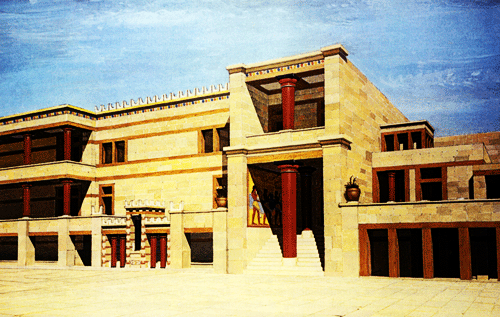

The Minoan cities were connected with stone-paved roads, formed from blocks cut with bronze saws. Streets were drained and water and sewer facilities were available to the upper class, through clay pipes.
Minoan buildings often had flat tiled roofs; plaster, wood, or flagstone floors, and stood two to three storeys high. Typically the lower walls were constructed of stone and rubble, and the upper walls of mudbrick. Ceiling timbers held up the roofs.
The materials used in constructing the villas and palaces varied, and could include sandstone, gypsum, or limestone. Equally, building techniques could also vary between different constructions; some palaces used ashlar masonry while others used roughly hewn megalithic blocks.

Palaces
The first palaces were constructed at the end of the Early Minoan period in the third millennium BC (Malia). While it was formerly believed that the foundation of the first palaces was synchronous and dated to the Middle Minoan at around 2000 BC (the date of the first palace at Knossos), scholars now think that palaces were built over a longer period in different locations, in response to local developments. The main older palaces are Knossos, Malia, and Phaistos. Some of the elements recorded in the Middle Minoan ‘palaces’ (Knossos, Phaistos and Mallia, for example) have precedents in earlier styles of construction in the Early Minoan period. These include the indented western court, and the special treatment given to the western façade. An example of this is seen at the “House on the Hill” at Vasiliki, dated to the Early Minoan II period.

The palaces fulfilled a plethora of functions: they served as centres of government, administrative offices, shrines, workshops, and storage spaces (e.g., for grain). These distinctions might have seemed artificial to Minoans.
The use of the term ‘palace’ for the older palaces, meaning a dynastic residence and seat of power, has recently come under criticism (see Palace), and the term ‘court building’ has been proposed instead. However, the original term is probably too well entrenched to be replaced. Architectural features such as ashlar masonry, orthostats, columns, open courts, staircases (implying upper stories), and the presence of diverse basins have been used to define palatial architecture.
Often the conventions of the better-known, younger palaces have been used to reconstruct older ones, but this practice may be obscuring fundamental functional differences. Most older palaces had only one story and no representative facades. They were U-shaped, with a big central court, and generally were smaller than later palaces.

Late palaces are characterised by multi-story buildings. The west facades had sandstone ashlar masonry. Knossos is the best-known example. See Knossos. Further building conventions could include storage magazines, a north-south orientation, a pillar room, a Minoan Hall system, a western court, and pier-and-door entrance ways. Palatial architecture in the First Palace Period is identified by its ‘square within a square’ style, whilst later, Second Palace Period constructions incorporated more internal divisions and corridors.
A common architectural standard among the Middle Minoan ‘palaces’ was that they are aligned with their surrounding topography. The MM palatial structure of Phaistos appears to align with Mount Ida, whilst Knossos is aligned with Juktas. These are oriented along a north-south axis. Scholars suggest the alignment was related to the sacred or ritual significance of the mountain, where a number of Peak Sanctuaries (spaces for public ritual) have been excavated (i.e., Petsophas). The material record for these sites show clusters of clay figurines and evidence of animal sacrifice.

Columns
One of the most notable contributions of Minoans to architecture is their unique column, which was wider at the top than the bottom. It is called an ‘inverted’ column because most Greek columns are wider at the bottom, creating an illusion of greater height. The columns were also made of wood as opposed to stone, and were generally painted red. They were mounted on a simple stone base and were topped with a pillow-like, round piece as a capital.
Villas
A number of compounds interpreted as ‘Villas’ have been excavated in Crete. These structures share many features with the central Palaces (i.e., a conspicuous western facade, storage facilities, and a ‘Minoan Hall’) of the Neopalatial era. These features may indicate either that they performed a similar role, or that the structures were artistic imitations, suggesting that their occupants were familiar with palatial culture. These villas are often richly decorated (see the frescos of Haghia Triadha Villa A). Source Wikipedia.
Be the first to comment